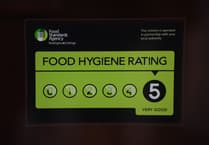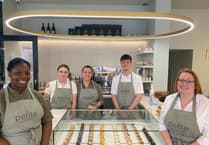SALLY Gaudern of Carpenters Close, Holybourne, sent me in this fascinating glimpse of Cold War preparations in Farnham during 1954.
Unfortunately we don’t know the publication in which this article appeared – it may, indeed, have been the Herald but until we can get the archive digitised it is not a simple thing to check (however, there are no photographs of the Food Flying Squad’s visit in the negative index which a small team of dedicated volunteers have been busy transcribing during the pandemic now extending to more than 90,000 entries).
DEMONSTRATION BY REIGATE-BASED FOOD FLYING SQUAD AT FARNHAM, SURREY
During the afternoon of Wednesday, 3rd March, the Reigate-based Food Flying Squad was on display in the car park at the Council Offices, Farnham, for inspection by members of Farnham Civil Defence Welfare Section and members of the Council. Among those who inspected the vehicles were Major H.C. Patrick, Chairman of the Council, Brigadier L.A. Fanshaw, Chairman of Farnham Civil Defence Committee, Mr. Holloway, County Training Officer, Mr. A.A. Minns, Clerk to the Council, and Miss Ealand, W.V.S. County Organiser, accompanied by Major R.M. Scott, Civil Defence Officer for Farnham.
The vehicles and equipment were described by Mr. Periam, Assistant Ministry of Food Principal Emergency Officer, South Eastern Region, who explained the part these convoys would play in any peacetime or wartime emergency. Manned by their W.V.S. crews, the convoys are ready to leave at short notice for the emergency site where they would serve hot food to the people until local emergency meals centres were organised.
The convoys, which are stationed at strategic points throughout the country, consist of an office van, a 500 gallon water tanker, two stores vans and four canteen vans, and are designed to act as the spearhead of emergency feeding. This convoy has already been in action at Canterbury in 1942, Dover in 1944, and the Kent floods in 1953, and these ‘Battle Honours’ are recorded on the side of each van.
The convoys carry their own Soyer boilers for boiling water and making soups and stews. But an alternative and very useful way of obtaining boiling water was demonstrated at Farnham Dairy, Weydon Lane, when the steam sterilising jets were used to heat water in the tea urns. The urns from the convoy canteen vans were filled with cold water at the dairy. A steam jet rapidly brought it to boiling point, the tea infusers were lowered into the boiling water and the tea was then ready for transport to the site of the emergency.
After watching this demonstration at the dairy, members of the C.D. Welfare Section and members of the Council were served with cups of tea from one of the convoy canteen vans at the Council Offices.
Thanks, Sally, for that timely reminder of the Cold War, an episode that all of us hoped was firmly consigned to the past but with recent world events that is much less certain. No doubt, as in 1954, the ability to brew tea in any situation will once again help to see us through.
Can readers recognise any of the people shown in the council yard photograph that accompanied the article (pictured below), I wonder?





Comments
This article has no comments yet. Be the first to leave a comment.